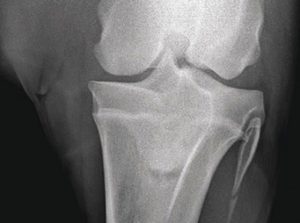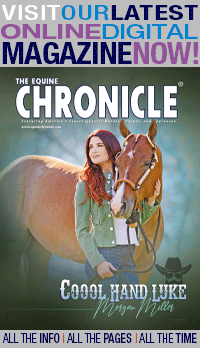Stifle Problems – Healing Soft Tissue Injuries
Click here to read the complete article490 – October, 2018
By Heather Smith Thomas
 The stifle is the largest and strongest joint in the horse’s hind leg, with 2 crescent-shaped discs of fibro-cartilage (the menisci) attached to the joint surface at the top of the tibia and 14 ligaments. It is actually 3 separate joints all hooked together. The first joint is between the femur (large bone from stifle to hip) and the patella (similar to the human kneecap) at the front of the stifle. The other 2 joints are between the femur and the tibia (the bone from stifle to hock), one on the inside (medial side) and the other on the outside (lateral side) of the limb.
The stifle is the largest and strongest joint in the horse’s hind leg, with 2 crescent-shaped discs of fibro-cartilage (the menisci) attached to the joint surface at the top of the tibia and 14 ligaments. It is actually 3 separate joints all hooked together. The first joint is between the femur (large bone from stifle to hip) and the patella (similar to the human kneecap) at the front of the stifle. The other 2 joints are between the femur and the tibia (the bone from stifle to hock), one on the inside (medial side) and the other on the outside (lateral side) of the limb.
Dr. David Frisbie, at the Equine Orthopedic Research Center, Colorado State University, has worked with many stifle problems. “In the past few years we’ve learned more about meniscal damage. The meniscus is a crescent-shaped cartilage-type structure dividing part of the stifle joint and providing support. In my practice, I see a case nearly every day in which the horse is sore in the stifle and it’s been x-rayed and the x-rays don’t show anything significant. Assuming it is soft tissue injury, the horse gets treated—usually with HA and steroids in the joint. Within 6 weeks or less the horse is lame again,” says Frisbie.
Most of these horses have some degree of meniscal or softtissue damage. “In years past, with surgery alone, the success rate for treatments ranged from 60% if it’s a grade 1 tear, down to about 6 or 7% success rate if it’s a grade 3 tear,” he says.
“The meniscus is the fibrocartilaginous pad that fills the space between the round contour of the distal femur and the flat top of the tibia,” says Dr. Scott McClure, Midwest Equine Surgery and Sports Medicine, in central Iowa. “It maintains some padding and congruency between the femur and the tibia; the meniscus fills in that joint and helps keep everything aligned and stable. It serves as a cupping device to allow the round femur to fit on top of the flat tibia,” he explains.
Medial meniscal injuries are one of the more common injuries seen in the medial joint. This is usually a tearing of the meniscus—the fibrous tissue at the top of the tibia. The meniscus is attached to the tibia by several ligaments, so some of those ligaments are often injured when the meniscus is injured, especially the medial collateral ligament that keeps the stifle aligned. Additionally, any of the other ligaments that hold the meniscus in place can be disrupted.
Click here to read the complete article490 – October, 2018










